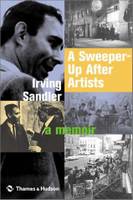Tuesday, July 27, 2004
Irving Sandler and His Push Broom
I’m currently mid-way through A Sweeper-Up After Artists, Irving Sandler’s new memoir of the 1950s and ’60s New York art scene.
 In the typical narrative of art history, we see a small pantheon of notables when we look back to that era—mostly men, mostly painters, mainly abstract expressionists. Sandler’s memoir reminds us, though, that life as it’s lived is never as neat or as simple as its documentation as history.
In the typical narrative of art history, we see a small pantheon of notables when we look back to that era—mostly men, mostly painters, mainly abstract expressionists. Sandler’s memoir reminds us, though, that life as it’s lived is never as neat or as simple as its documentation as history.
Reading Sandler, I’ve been surprised to see how diverse the work was that was being done in those years and how much controversy there was within the community that produced it. Aesthetics and ethics fused for many people in Sandler’s circle, and they argued violently and for hours at a time about the rights and wrongs of the artistic choices they were making.
Rather than giving us another history of this period, Sandler shows us what it was like to be there as art history was in the process of being made. His memoir conveys some of the narrative richness and complexity of character that gets washed out of most histories.
If this is what a good sweeper-up does, we should all hope there’s someone walking around the streets of Brooklyn today with a broom the size of Sandler’s.
 In the typical narrative of art history, we see a small pantheon of notables when we look back to that era—mostly men, mostly painters, mainly abstract expressionists. Sandler’s memoir reminds us, though, that life as it’s lived is never as neat or as simple as its documentation as history.
In the typical narrative of art history, we see a small pantheon of notables when we look back to that era—mostly men, mostly painters, mainly abstract expressionists. Sandler’s memoir reminds us, though, that life as it’s lived is never as neat or as simple as its documentation as history.
Reading Sandler, I’ve been surprised to see how diverse the work was that was being done in those years and how much controversy there was within the community that produced it. Aesthetics and ethics fused for many people in Sandler’s circle, and they argued violently and for hours at a time about the rights and wrongs of the artistic choices they were making.
Rather than giving us another history of this period, Sandler shows us what it was like to be there as art history was in the process of being made. His memoir conveys some of the narrative richness and complexity of character that gets washed out of most histories.
If this is what a good sweeper-up does, we should all hope there’s someone walking around the streets of Brooklyn today with a broom the size of Sandler’s.